SO, I'M BLOGGING NOW...
May 11, 2025 | 5:45 PM
Recently, I've come to a somewhat late realisation: I hate social media. I quit Instagram earlier this year because let's face it, it's a cesspit. It's like anonymity has sucked up every ounce of positivity in people, every comment section is just filled with the most heinous and degrading commentary. Remember when Instagram was just a photo-sharing platform and not a forum for homophobia, transphobia, racism and ableism; that was nice. And I hate how dependent I was on social media, like my brain had been hard-wired to doom scroll whenever I was in any proximity to my phone. Like, what does it do for me? It wasn't like it made me happy; it just left me feeling overwhelmed.
So, why is any of this relevant? Well, if I want to grow as an artist, I have to promote myself. Unfortunately, Instagram happens to be the most convenient tool, and it's what I've been using since I started college (about 5 years). However, I feel that social media has altered the way I approach my work. Each post I made didn't feel like a promotion, more like a need for validation. And I think it made me lazier as an artist, like I couldn't be bothered to make anything with the expectation of a post. And don't get me started on the algorithm and its preference for "Reels". Social media has made me feel uninspired as an artist, and having to conform to the algorithm's "game" is just tiring.
Blogging. I never really considered this as a form of promotion, but here we are. I feel like my presence on social media was very manufactured, like I wasn't truly myself. So, maybe this may work better for me. There has been a lot of work I would still like to talk about, but I simply couldn't be bothered to post about it. Like the work towards my final degree show, I am excited about the process, but very little of it has been documented.
I'm going to treat this blog like a diary. A dysfunctional account of my ongoings and whereabouts.
CYMATIC PROCESSES & THE OSCILLOSCOPE
May 24, 2025 | 3:10 PM
I'm starting to consider my next project going into my MA. I want to continue my work on neurodiverse sensory perception, applying cymatic processes as a vehicle. As my previous projects have been video/installation based, I'm inclined to focus on physical material. I have briefly experimented with sound and "water-grams" in the darkroom, which develop unpredictable patterns in correspondence with the frequencies applied; visibly comparable to Pierre Cordier's "chemigram".
I've been looking into alternative processes that I could incorporate into my practice. I have a newfound interest in the oscilloscope.
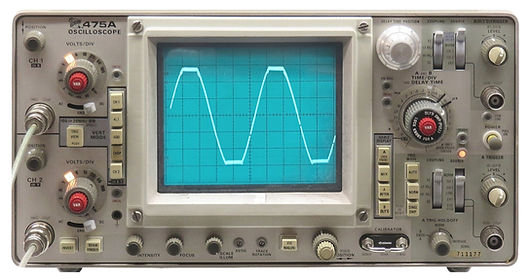
Tektronix Oscilloscope 475A
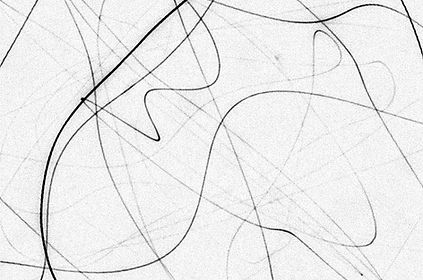
Oscilloscope responding to "3" by Aphex Twin
Oscilloscopes are typically used to visualise and measure signals in electrical applications. Similar to my practice with cymatics, the electrical signals manipulate the forms that appear on the screen. Using dood.al, I uploaded an audio sample to the online software and took 3 screenshots (beginning, middle, and end of audio). As you can see above, I merged the screenshots so that they are all visible in a single image. There is something here I can work with.
My next step in working with this process is applying my own audio samples and maybe creating some double-exposures with imagery in the darkroom. It will be interesting to see these oscilloscopic marks interact with subject matter.
DARKROOM OSCILLO-GRAPHY?
May 27, 2025 | 12:27 PM
I am going ahead with this process, which I am dubbing "oscillography". I've looked on the internet to see I anyone has done something remotely like this, but it seems like this is an untouched process. I've put together a manual for anyone who would like to try this process in their own darkroom space. I'm also interested in the idea of destruction and how that speaks on my research. In a darkroom context, I am reminded of "solarisation", which was a prominent technique in the Surrealist era of photography.

Solarised Double Portrait (cir. 1930), Ray, M.

Masque Panu (1937), Tabard, M.
Surrealist pioneers such as Ray and Tabard used this technique extensively in their work. It creates an almost ethereal effect, like the subject matter is rising from the paper. But at times, it's been used to embrace the obscurity of the Surrealist movement and its nonsensical manner. Rounding back to the theme of destruction, solarisation intentionally goes against the traditional process of development.
I need to scout out some locations for my first trial run of this process, preferably loud and busy spaces.
PROJECTING, NOT ENLARGING
May 28, 2025 | 2:07 PM
My enthusiasm for this project has been rampant recently, and I seem to be finding more and more approaches. What sparked my mind was the idea of projecting directly onto photo paper, not from an enlarger but an LCD projector. I've found a methodology for collecting material, which will inform what is created in the darkroom. I'm going to collect 5 audio samples from a chosen location, run them through the oscilloscope emulator, and layer them together in Premiere Pro. This should result in a jarring combination of sounds and forms. I want to use a projector to expose these forms, hopefully transferring them onto the paper when developing.
Will this work? I'm not sure. I'm honestly anticipating the light from the projector's lens to cause some light-leaking. But it's worth trying; I've never tried anything like this, so whatever happens will be a surprise to me.
TANGLED NERVES
May 29, 2025 | 1:12 PM
I have found some success connecting the oscilloscope to imagery. I ran some found audio through the oscilloscope emulator, this time increasing the persistence, which causes a blurring effect. As I've done before, I layered the screen-captures together but this time, I introduced an image to the layering.
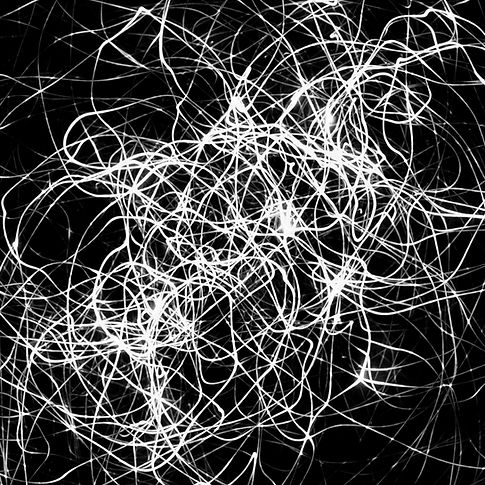
Layered oscilloscope captures
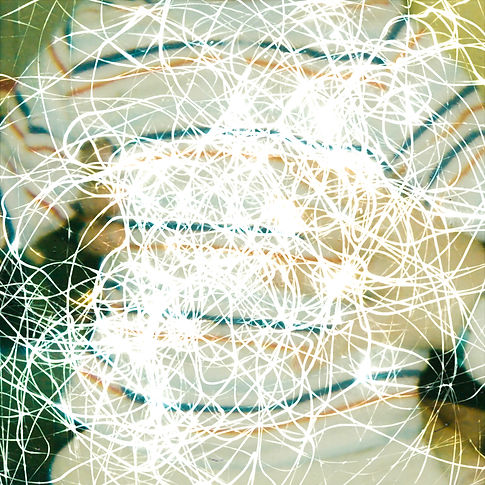
Captures layered over image
What came out of this is what I would describe as "tangled nerves", which directly links to sensory perception among the neurodiverse. I like how you can barely make out what the image is, as the oscilloscopic marks obscure it. I debated whether to convert the image to monochrome, but when I tried, the image became more lost than it already was. Besides, I haven't worked with colour in a while, and it can open some doors to further experimentation in the darkroom. I also think it's appropriate to stick with the square format to keep consistent with the oscilloscope format.
LIFE UPDATE (or lack of...)
July 20, 2025 | 3:05 PM
So, let's address the elephant in the room: I haven't been keeping you updated. I mean, my last post on here was about two months ago, so you'd hope that I've accomplished some things within that timeframe. And yes, there are a few developments in my life that I feel are worth mentioning.
First and foremost, I graduated! After three years of projects and essays, I have completed my BA. When I was in secondary school, the idea of me going to university, or college for that matter, was a complete afterthought. I think I was fed this glamourised idea of university being this large-scale, formal environment, where I would be completely incapable of handling the workload. Oh, how wrong was I? Maybe it's an arts school thing, but the overall atmosphere of the university is just so welcoming and the lecturers were no where near my presumptions. I can't wait to do it all over again when I begin to study my MA. After a solid half-hour of patterned clapping, I finally walked across that stage and shook hands with the chancellor. I officially graduated.
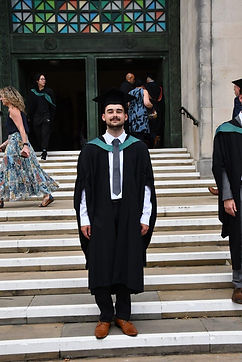
In other news, I have figured out which direction I want to take my research. In my previous posts, I have expressed my newfound love for the oscilloscope and its artistic application to make work. I have subconsciously been recording audio clips from my environment, hoping to use them in some form of a creative project. I have decided that I want to carry out an audio-visual data collection, using the oscilloscope as a means of visualising sound. The end goal of this research project is to develop an extensive document (or photo-book) compiling all my findings, whilst also allowing me to provide some dialogue on how it relates to the concept of sensory stimuli response. Here's an example using an audio clip I captured in the Tate Modern during a trip to London last month:


Layered oscilloscope frames responding to Cildo Meireles' Babel (2001) at Tate Modern
With a bit of reworking in Photoshop, I created this visualisation of the audio source by layering multiple captures on top of each other to create this abstraction of frantic lines. I hope that by experimenting with other audio sources, I will garner a collection of these unique visualisers. Where this will take me in terms of my MA, I'm not sure, but it's something to do during this empty space before going back to normality.
HAFOD COPPERWORKS
July 26, 2025 | 5:55 PM
I took a cycle down to the Hafod Copperworks for a spontaneous shoot around. I gave me a good opportunity to test out my new Canon R50 which, in comparison to my Nikon D7100, is a lot more compact and lightweight. I've had my Nikon for about 5-6 years so I think a new one was in order. Plus, it's mirrorless.
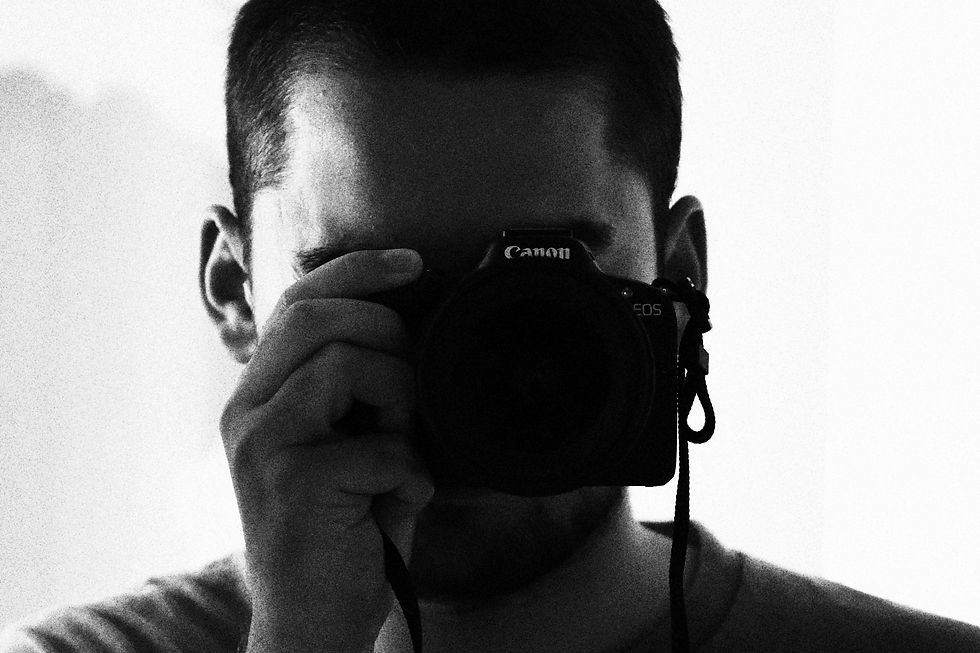
Canon R5O with a 24-105mm F4-7.1 RF lens
Forgot to mention, this camera has a sort of internal filter setting that allows me to shoot directly in monochrome with a touch of gritty grain, sort of mimicking the "aesthetic" of a 35mm. Back to the copperworks, this shoot took place across 3 different sub-locations: facing Bascal Bridge, under another bridge, and finishing at the Hafod Copperworks. It's funny to think Morfa used to flourish as an industrial area, but would later become an area of retail distribution. What remains of Swansea's industrial past is swept behind an influx of trees across the River Tawe. Though it seems like there's some sort of preservation going on, as the primary space of the copperworks is barricaded and construction vehicles are present.












UPDATE ON RESEARCH PROJECT
August 18, 2025 | 2:28 PM
There's been some good progress on my research project, which I am calling INTO SONUS (working title, of course). I think I initially proposed going out and collecting new audio samples; however, this is pointless, as I have already been subconsciously doing this for the past year. I guess I was planning to do something with them in the darkroom with my subwoofer, but obviously, I can't do that right now.
I want to say I have about 30-40 audio samples in my voice memos, and I have already gone through 15 of them. The process is tedious, but the difference in results is noticeable. What I've picked up is that audio clips with lower frequencies had fewer movements, compared to the higher frequencies, which came out far more erratically.

Manselton Racecourse

Puerto Blanco
RESEARCH PROJECT: COMPLETE (for now)
September 18, 2025 | 4:05 PM
My research project has concluded. I've made my way through a very disorganised list of audio recordings and translated them into visually abstract data. I definitely overshot my prediction on the volume of material I would end up with, as it totalled 17. However, this is just enough to progress forward, given the stark differences in forms and wave motion. It's at least a proof of concept, as it showed similarities in how frequencies affected the visual outcome.






It would be interesting to try using a real oscilloscope for this process instead of an online emulator. I've eyed some up on eBay, and the prices are surprisingly reasonable. That being said, that would mean I'd need to adjust my approach in methodology.
NEUROGRAPHICA
September 21, 2025 | 5:16 PM
So, I was scrolling through my Pinterest feed (as I usually do out of boredom) and I came across this abstract sketch by Laetyn Miller, with the post titled "Neurographic Art". As someone who's practice revolves around neurodiversity and brain functionality, I've surprisingly never came across this artform; perhaps because it centres around fine art practice as opposed to photography.

Neurographic Art (2025). Miller, L.

Neurographic artwork (no date). Piskarev, P.
Pavel Piskarev coined this practice as an art-based form of meditation. This technique involves a series of psychologically-led scribbles on a piece of paper. The finished product presents itself in abstract forms, somewhat resembling a cluster of neurons.
If it wasn't already apparent, I'm thinking of ways to incorporate this practice within my work. Visually, this method is reminiscent of my oscillography research, in the sense that they both appear as a bunch of nonsensical lines. However, Neurographica lends itself as being directly connected to the human psyche, whereas oscillography is merely a translation of sensory to visual. Considering this approach is a lot more hands-on and can speak on personal experience, Neurographica can also invite collaboration (perhaps there's a project in that). Now, applying this methodology to a photographic context may be a challenge, given that it is primarily fine art-based. My initial thought involved creating these marks on a piece of acetate and superimposing them onto light-sensitive paper. Coinciding with this, I can introduce watergrams into the process. By layering the acetate onto the paper whilst it's being exposed, an audio sample which relates to the neurographic drawing can be used to create abstract forms within an already abstract form. We'll see how that goes; I start back at university soon, so I'll be able to create something within the coming weeks.
FIVE WEEKS IN
November 4, 2025 | 6:14 PM
Once again, I've abandoned this blog out of procrastination. That being said, there is a good reason; I've started my MA. There are about 70 students altogether, including a few familiar faces from my BA, all practising across various artistic mediums.
Our first practical module, suitably titled the "Thought Experiment", starts with a prompt excerpted from Roger-Pol Droit's "101 Experiments in the Philosophy of Everyday Life". I have done a similar task during the BA under the Fugitive Testimonies module, where we started a project from an archival reference. However, this module bars us from our specific pathways (in my case, I can't use photography). This definitely throws me into the deep end, but at least it pushes me to engage with other processes and ideas. My prompt is as follows: "Invent lives for yourself". The outcome of this module will be a Pecha Kucha lasting four minutes and thirty-three seconds; what we do with that time is ambiguous.